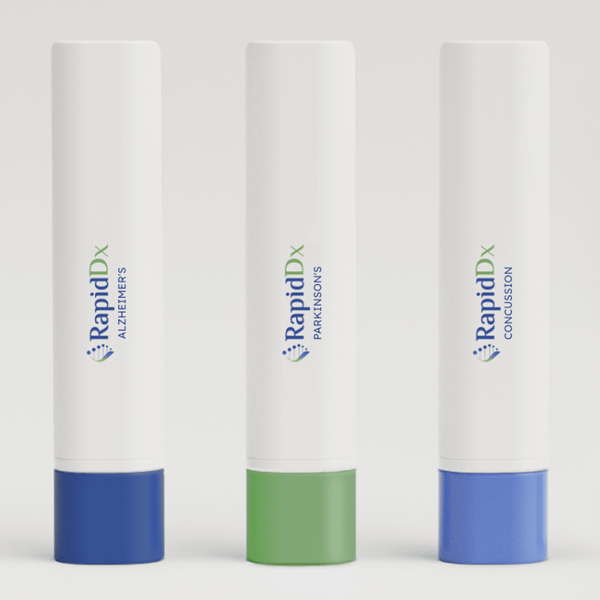Testing Saliva
Saliva as a Medical Assessment Medium
The effective use of saliva for diagnostic tests has been proven since salivary cortisol was first measured in the 1970s. It has been more than a decade since the FDA approved over-the-counter HIV tests using saliva. During the COVID-19 pandemic, this testing method gained worldwide acceptance, leading to increased oral testing for various diseases.
RapidDx saliva-based assessments
Developed to address the critical need for early-stage diagnostic tests for life-altering diseases, RapidDx is designed to be a handheld diagnostic device intended to alert clinicians when a patient carries specific biomarkers indicating the presence of targeted conditions.
RapidDX is developing a patented sample collection and assessment device and focused its attention on Alzheimer’s and Parkinson’s disease and traumatic brain injury (TBI) or concussion.

Why Saliva?
Beyond the advantage of noninvasive and easy collection, saliva is recognised as a unique and complex biofluid, described as a “mirror of the body” and a “gateway” to physiological information.
Some of the advantages include:
Non-Invasive Collection
Biomarkers
Point-of-Care (POC) Devices
Transportation and Disposal
Regulatory Approvals
Disease Detection
Saliva has also been approved by FDA and EU authorities for the detection of certain diseases or for other purposes, including HIV/AIDS and COVID-19.
Saliva-based diagnostics have shown promise in detecting various other diseases. Here are examples of diseases under investigation:
Oral Diseases
- Periodontal Disease: Saliva contains biomarkers related to gum health, aiding in early detection of periodontal disease.
- Oral Cancer: Certain proteins and genetic markers in saliva can indicate oral cancer risk.
Systemic Diseases
- Diabetes: Levels of various salivary biomarkers correlate with blood glucose levels, making these biomarkers useful for monitoring diabetes.
- Autoimmune Diseases: Saliva biomarkers may help diagnose conditions like Sjögren’s syndrome and systemic lupus erythematosus.
- Cardiovascular Diseases: Some studies explore saliva markers for heart disease risk assessment.
Infectious Diseases
Hepatitis B and C: Saliva-based tests are being researched for these viral infections.
Drugs of Abuse
There are many saliva drugs of abuse tests that detect marijuana [THC] and other abused drugs. Saliva is actually a better indicator of impairment in subjects over the limit for THC.
General Wellness/ Women’s Health
Various hormones in saliva are used to provide an indication of overall wellness and for women’s health issues. Hormones in saliva are present in the “non-complexed” forms whereas in blood the hormone molecules are “complexed”. As a result salivary hormones reflect the true values.
In Summary
Saliva’s ease of collection, cost-effectiveness, and potential as a diagnostic medium make it an exciting area of research for detecting systemic diseases. While challenges remain, ongoing studies continue to explore its usefulness as an important diagnostic tool.
